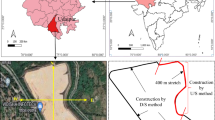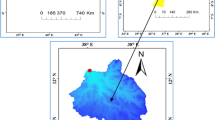Abstract
The height of tailings pond (TP) embankments is frequently raised to accommodate the ever-increasing volume of tailings released by the mining industries. Excess pore water pressure (EPWP) may develop during the height-raising operations, which can affect the overall stability of TP. This article presents a detailed stability analysis for the embankments of an existing TP, the height of which was increased twice utilizing downstream (D/S) and upstream (U/S) construction techniques. A rigorous two-dimensional transient fully coupled-stress-pore pressure analysis is performed in the finite element-based package RS2 to examine the build-up of EPWP during different stages of construction. Furthermore, an attempt is made to investigate the feasibility of future height raising, with due consideration given to the influence of embankment raising rates. Results from the analysis show a development of higher EPWP within the tailings deposit in comparison to the embankments of TP, indicating the development of an undrained-like condition. The study further reveals that the development of EPWP is highly affected by the rate at which embankments of TP are being raised. A higher rate of embankment-raising results in the development of greater EPWP in comparison to a lower embankment-raising rate, which may lead to the ultimate collapse of TP. Furthermore, based on the stability analysis, the height of existing TP can be further raised by 4 m (two lifts of 2 m height) utilizing the U/S construction technique. A thorough cost and benefit analyses are however required before implementing the results of the current analysis since the storage capacity of TP is reduced while raising by the U/S method.






















Similar content being viewed by others
References
Dong L, Deng S, Wang F (2020) Some developments and new insights for environmental sustainability and disaster control of tailings dam. J Clean Prod 269:122270. https://doi.org/10.1016/j.jclepro.2020.122270
Vick SG (1990) Planning, design, and analysis of tailings dams. BiTech, Richmond, BC, Canada
Davies MP (2001) Impounded mine tailings: what are the failures telling us? CIM Bulletin:53–59
USCOLD (1994) Tailings dam incidents. U.S. Committee on Large Dams, Denver, CO
Rico M, Benito G, Salgueiro AR, Díez-Herrero A, Pereira HG (2008) Reported tailings dam failures: a review of the European incidents in the worldwide context. Journal of Hazard Mater 152(2):846–852. https://doi.org/10.1016/j.jhazmat.2007.07.050
Sitharam TG, Hegde A (2017) Stability analysis of rockfill tailing dam: an Indian case study. Int. J Geotech Eng 11(4):332–342. https://doi.org/10.1080/19386362.2016.1221574
Coulibaly Y, Belem T, Cheng L (2017) Numerical analysis and geophysical monitoring for stability assessment of the Northwest tailings dam at Westwood Mine. Int J Min Sci Technol 27(4):701–710. https://doi.org/10.1016/j.ijmst.2017.05.012
Pak A, Nabipour M (2017) Numerical study of the effects of drainage systems on saturated/unsaturated seepage and stability of tailings dams. Mine Water Environ 36(3):341–355. https://doi.org/10.1007/s10230-017-0468-y
Zhang C, Chai J, Cao J, Xu Z, Qin Y, Lv Z (2020) Numerical simulation of seepage and stability of tailings dams: a case study in Lixi, China. Water 12(3):742. https://doi.org/10.3390/w100810
Zandarín MT, Oldecop LA, Rodríguez R, Zabala F (2009) The role of capillary water in the stability of tailing dams. Eng Geol 105(1-2):108–118. https://doi.org/10.1016/2Fj.enggeo.2008.12.003
Saad B, Mitri H (2011) Hydromechanical analysis of upstream tailings disposal facilities. J Geotech Geoenviron 137(1):27–42. https://doi.org/10.1061/(ASCE)GT.1943-5606.0000403
Do TM, Laue J, Mattsson H, Jia Q (2021) Numerical analysis of an upstream tailings dam subjected to pond filling rates. Appl Sci 11(13):6044. https://doi.org/10.3390/app11136044
Singh S, Kumar A, Sitharam TG (2021) Stability investigation of embankments of a tailings pond with varying embankment raising rate. In: In Proceedings of the Tailings and Mine Waste conference, Banff, Alberta, Canada Nov 7-10
Ormann L, Zardari MA, Mattsson H, Bjelkevik A, Knutsson S (2013) Numerical analysis of strengthening by rockfill embankments on an upstream tailings dam. Can Geotech J 50(4):391–399. https://doi.org/10.1139/cgj-2012-0255
García-Giménez R, Jiménez-Ballesta R (2017) Mine tailings influencing soil contamination by potentially toxic elements. Environ Earth Sci 76(1):51. https://doi.org/10.1007/s12665-016-6376-9
(2016) Indian Standard criteria for earthquake resistant design of structures. Part 1: General provisions and buildings. In: IS 1893. Bureau of Indian Standard, New Delhi
Biot MA (1941) General theory of three-dimensional consolidation. J Appl Phys 12(2):155–164. https://doi.org/10.1063/1.1712886
Smith IM, Griffiths DV (1997) Programming the finite element method. John Wiley & Sons
Rocscience, Inc. RS2 Version 11.003 (2020) Finite element analysis for excavations and slopes. Toronto, Ontario, Canada.
Naeini M, Akhtarpour A (2018) Numerical analysis of seismic stability of a high centerline tailings dam. Soil Dyn Earthq Eng 107:179–194. https://doi.org/10.1016/j.soildyn.2018.01.019
Bishop AW (1959) The principles of effective stress. Teknisk Ukeblad 106(39):859–863
van Genuchten MT (1980) A closed-form equation for predicting the hydraulic conductivity of unsaturated soils. Soil Sci Soc Am J 44(5):892–898. https://doi.org/10.2136/sssaj1980.03615995004400050002
Mualem Y (1976) A new model for predicting the hydraulic conductivity of unsaturated porous media. Water Resour Res 12(3):513–522. https://doi.org/10.1029/WR012i003p00513
Fredlund DG, Rahardjo H (1993) Soil mechanics for unsaturated soils. John Wiley & Sons
Vereecken H, Weynants M, Javaux M, Pachepsky Y, Schaap MG, van Genuchten MT (2010) Using pedotransfer functions to estimate the van Genuchten–Mualem soil hydraulic properties: a review. Vadose Zone J 9(4):795–820. https://doi.org/10.2136/vzj2010.0045
Vogel T, van Genuchten MT, Cislerova M (2000) Effect of the shape of the soil hydraulic functions near saturation on variably saturated flow predictions. Adv Water Resour 24(2):133–144. https://doi.org/10.1016/S0309-1708%2800%2900037-3
Berg RR, Christopher BR, Samtani NC (2009) Design and construction of mechanically stabilized earth walls and reinforced soil slopes. Federal High Way Administration (FHWA), Vol-I, United State
IS 14739 (1999) Geotextiles- method for determination of creep. Bureau of Indian Standard, New Delhi.
ASTM D 5322 (2017) Standard practice for laboratory immersion procedures for evaluating the chemical resistance of geosynthetics to liquids. ASTM, West Conshohocken, PA.
Koerner RM, Martin JP, Koerner GR (1986) Shear strength parameters between geomembranes and cohesive soils. Geotext Geomembr 4(1):21–30. https://doi.org/10.1016/0266-1144(86)90034-8
Choudhury D, Katdare AD, Shukla SK, Basha BM, Ghosh P (2014) Seismic behaviour of retaining structures, design issues and requalification techniques. Indian Geotech J 44(2):167–182. https://doi.org/10.1007/s40098-014-0100-z
Singh S, Kumar A (2021) Methodologies available for the determination of seismic active thrust acting on retaining walls: a critical review. Indian Geotech J 51(5):1056–1068. https://doi.org/10.1007/s40098-020-00495-3
IS 7894 (1975) Code of practice for the stability analysis of the earth dams. Bureau of Indian Standards, New Delhi.
Jewell RA (1996) Soil reinforcement with geotextiles, Special Publication 123. Construction Industry Research and Information Association, London
Justo JL, Morales-Esteban A, Justo E, Jiménez-Cantizano FA, Durand P, Vázquez-Boza M (2019) The dry closure of the Almagrera tailings dam: detailed modelling, monitoring results and environmental aspects. Bull Eng Geol Environ 78(5):3175–3189. https://doi.org/10.1007/s10064-018-1342-2
Acknowledgements
The authors are thankful to International Coal Ventures Pvt. Ltd. (ICVL) for sharing all the data required in the present analyses. It would have been impossible to carry out the present work without the data received from ICVL.
Author information
Authors and Affiliations
Corresponding author
Ethics declarations
Conflict of interest
The authors declare no competing interests.
Additional information
Publisher’s Note
Springer Nature remains neutral with regard to jurisdictional claims in published maps and institutional affiliations.
Rights and permissions
Springer Nature or its licensor (e.g. a society or other partner) holds exclusive rights to this article under a publishing agreement with the author(s) or other rightsholder(s); author self-archiving of the accepted manuscript version of this article is solely governed by the terms of such publishing agreement and applicable law.
About this article
Cite this article
Singh, S., Kumar, A. & Sitharam, T.G. Stability Assessment of a Tailings Pond Considering the Effect of Staged Construction and Embankment Raising Rate: a Numerical Study. Mining, Metallurgy & Exploration 40, 851–869 (2023). https://doi.org/10.1007/s42461-023-00772-8
Received:
Accepted:
Published:
Issue Date:
DOI: https://doi.org/10.1007/s42461-023-00772-8




